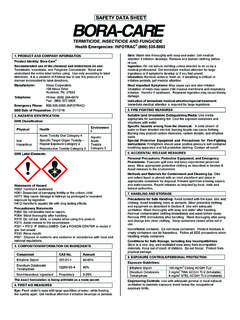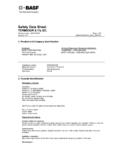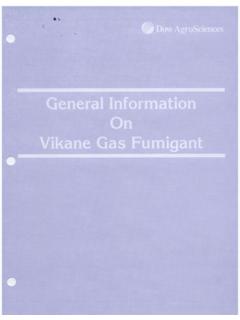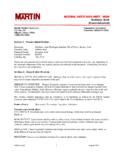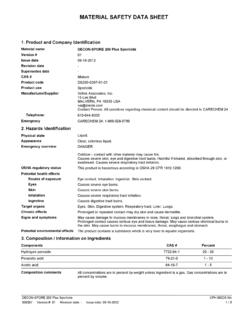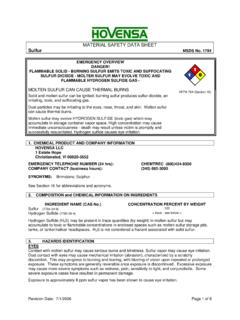Transcription of Page 1/15 Safety Data Sheet (SDS) - PESTGON.COM
1 Page 1/15 Safety data Sheet (SDS) OSHA HazCom Standard 29 CFR (g) and GHS Rev 03. Printing date 04/02/2015 Reviewed on 04/02/2015 Product identifier Trade name: Fumitoxin Tablets - EPA Reg. No. 72959-1; Fumitoxin Pellets - EPA Reg. No. 72959-2 Relevant identified uses of the substance or mixture and uses advised against Product description Fumigant for Insect & Rodent Control Application of the substance / the mixture Fumigants used to treat raw agricultural commodities, processed foods, non-food commodities and rodent burrows. Details of the supplier of the Safety data Sheet Manufacturer/Supplier: DEGESCH America, Inc. 153 Triangle Dr. Box 116 Weyers Cave, VA 24486 USA Telephone: (540) 234-9281 / 800-330-2525 Telefax: (540) 234-8225 Emergency telephone number: For human or animal emergencies: 1-800-308-4856 (Rocky Mountain Poison and Drug Center) For all other chemical emergencies: 1-800-424-9300 (Chemtrec) Emergency and Information - DEGESCH America, Inc.
2 : (540) 234-9281 / 800-330-2525 Classification of the substance or mixture GHS02 Flame Water-react. 1 H260 In contact with water releases flammable gases which may ignite spontaneously. GHS06 Skull and crossbones Acute Tox. 2 H300 Fatal if swallowed. Acute Tox. 2 H330 Fatal if inhaled. GHS05 Corrosion Eye Dam. 1 H318 Causes serious eye damage. GHS09 Environment Aquatic Acute 1 H400 Very toxic to aquatic life. GHS07 (Contd. on page 2) * 2 Hazard(s) identification * 1 Identification Page 2/15 Safety data Sheet (SDS) OSHA HazCom Standard 29 CFR (g) and GHS Rev 03. Printing date 04/02/2015 Reviewed on 04/02/2015 Trade name: Fumitoxin Tablets - EPA Reg.
3 No. 72959-1; Fumitoxin Pellets - EPA Reg. No. 72959-2 Skin Irrit. 2 H315 Causes skin irritation. Label elements GHS label elements The product is classified and labeled according to the Globally Harmonized System (GHS). Hazard pictograms GHS02 GHS05 GHS06 GHS09 Signal word Danger Hazard-determining components of labeling: Aluminum Phosphide Ammonium Carbamate Hazard statements In contact with water releases flammable gases which may ignite spontaneously. Fatal if swallowed or if inhaled. Causes skin irritation. Causes serious eye damage. Very toxic to aquatic life. Precautionary statements Keep away from any possible contact with water, because of violent reaction and possible flash fire. Do not breathe dust/fume/gas/mist/vapors/spray. Wear respiratory protection. Wear protective gloves/protective clothing/eye protection/face protection.
4 Avoid release to the environment. Wash thoroughly after handling. Do not eat, drink or smoke when using this product. If swallowed: Immediately call a poison center/doctor. If in eyes: Rinse cautiously with water for several minutes. Remove contact lenses, if present and easy to do. Continue rinsing. Specific treatment is urgent (see supplementary first aid instructions on this Safety data Sheet ). IF INHALED: Remove victim to fresh air and keep at rest in a position comfortable for breathing. If skin irritation occurs: Get medical advice/attention. In case of fire: Use for extinction: CO2, sand, extinguishing powder. If on skin: Wash with plenty of water. Collect spillage. Take off contaminated clothing and wash it before reuse. Store locked up. Store in a well-ventilated place. Keep container tightly closed. Store in a dry place. Store in a closed container.
5 Dispose of contents/container in accordance with local/regional/national/international regulations. Unknown acute toxicity: percent of the mixture consists of ingredient(s) of unknown toxicity. (Contd. on page 3) Page 3/15 Safety data Sheet (SDS) OSHA HazCom Standard 29 CFR (g) and GHS Rev 03. Printing date 04/02/2015 Reviewed on 04/02/2015 Trade name: Fumitoxin Tablets - EPA Reg. No. 72959-1; Fumitoxin Pellets - EPA Reg. No. 72959-2 Classification system: NFPA ratings (scale 0 - 4) Health = 4 Fire = 4 Reactivity = 2 The substance demonstrates unusual reactivity with water. HMIS-ratings (scale 0 - 4) Health = *4 Fire = 4 Reactivity = 2 Other hazards None known Chemical characterization: Mixtures Description: Mixture of substances listed below with nonhazardous additions. Dangerous Components: CAS: 20859-73-8 RTECS: BD 1400000 Aluminum Phosphide 55% Water-react.
6 1, H260; Acute Tox. 2, H300; Aquatic Acute 1, H400 CAS: 1111-78-0 Ammonium Carbamate Proprietary% Eye Dam. 1, H318; Acute Tox. 4, H302; Skin Irrit. 2, H315; Aquatic Acute 3, H402 RTECS: BD 1200000 Proprietary 5-10% STOT SE 3, H335 Proprietary 2-12% Skin Irrit. 2, H315; STOT SE 3, H335; Eye Irrit. 2B, H320 Additional information: Fumitoxin Tablets and Fumitoxin Pellets react with water to produce phosphine ( hydrogen phosphide, PH3, CAS No. 7803-51-2) as shown in Equation 1. Fumitoxin products are formulated with 55% aluminum phosphide and also contains ammonium carbamate (AC) and inert ingredients. Ammonium carbamate decomposes to liberate ammonia (CAS No. 7664-41-7) and carbon dioxide (CAS No. 124-38-9) as shown in Equation 2. 1) AlP + 3H2O --- > Al(OH)3 + PH3 2) NH2 COONH4 --- > 2NH3 + CO2 Description of first aid measures General information: Symptoms of overexposure are headache, dizziness, nausea, difficult breathing, vomiting, and diarrhea.
7 In ALL cases of overexposure, get medical attention immediately. Take victim to a doctor or emergency treatment facility. Have product container label or applicator's manual with you when calling a poison control center, doctor, or when going for treatment. (Contd. on page 4) * 4 First-aid measures * 3 Composition/information on ingredients 4 4 2 W HEALTH *4 FIRE 4 REACTIVITY 2 Page 4/15 Safety data Sheet (SDS) OSHA HazCom Standard 29 CFR (g) and GHS Rev 03. Printing date 04/02/2015 Reviewed on 04/02/2015 Trade name: Fumitoxin Tablets - EPA Reg. No. 72959-1; Fumitoxin Pellets - EPA Reg. No. 72959-2 After inhalation: Get exposed person to fresh air. If person is not breathing, call 911 or an ambulance, then give artificial respiration, preferably by mouth to mouth, if possible. Contact a poison control center or doctor for treatment advice.
8 After skin contact: Take off contaminated clothing immediately. Rinse skin immediately with plenty of water for 15-20 minutes. Call a poison control center or doctor for treatment advice. After eye contact: Hold eye open and rinse slowly and gently with water for 15-20 minutes. Remove contact lenses, if present, after the first 5 minutes, then continue rinsing eyes. Call a poison control center or doctor for treatment advice. After swallowing: Call a poison control center or doctor immediately for treatment advice. Have person sip a glass of water if able to swallow. Do not give anything by mouth to an unconscious person. Do not induce vomiting unless told to by a poison control center or doctor. Information for doctor: Most important symptoms and effects, both acute and delayed Aluminum phosphide fumigant products react with moisture from the air, acids and many other liquids to release phosphine gas ( hydrogen phosphide, PH3).
9 Mild exposure by inhalation causes malaise (indefinite feeling of sickness), headache, ringing in the ears, fatigue, nausea and pressure in the chest which is relieved by removal to fresh aid. Moderate poisoning causes weakness, vomiting, pain just above the stomach, chest pain, diarrhea and dyspnea (difficulty breathing). Symptoms of severe poisoning may occur within a few hours to several days resulting in pulmonary edema and may lead to dizziness, cyanosis, unconsciousness, and death. Indication of any immediate medical attention and special treatment needed No further relevant information available. Extinguishing media Suitable extinguishing agents: CO2, sand, extinguishing powder. Do not use water. For Safety reasons unsuitable extinguishing agents: Water Special hazards arising from the substance or mixture Phosphine ( hydrogen phosphide, PH3)-air mixtures at concentrations above the LEL of v/v (18,000 ppm) may ignite spontaneously.
10 ignition of high concentrations of phosphine gas ( hydrogen phosphide, PH3) can product a very energetic reaction. Explosions can occur under these conditions and may cause severe personal injury. Never allow the buildup of phosphine gas ( hydrogen phosphide, PH3) to exceed explosive concentrations. Open containers of metal phosphides in open air only and never in a flammable atmosphere. Do not confine spent or partially spent dust from metal phosphide fumigants as the slow release of phosphine gas ( hydrogen phosphide, PH3) from these materials may result in the formation of an explosive atmosphere. Spontaneous ignition may occur if large quantities of aluminum phosphide are piled in contact with liquid water. This is particularly true if quantities of these materials are placed in an environment which can provide partial confinement of the hydrogen phosphide gas liberated by hydrolysis.


